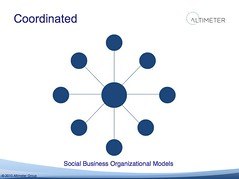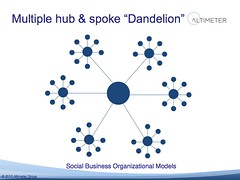Yesterday’s webinar, you can view all slides (including these graphics below, and recording) on getting your company ready for social included a section on organizational models. I wanted to share more in the usual web strategy matrix style as 5 minutes on a webinar isn’t really enough to do a complicated topic justice. Interestingly enough, I’m often called into companies that are moving out of organic and into coordinated, or dandelion model as a central team needs help working with various business units and setting up the internal program. I plan to do a detailed research report on this topic in Q3, to find out how companies are organizing. First, let’s take a look at the different models that exist to provide blanked education to the market:
Frameworks: Organic, Centralized, Coordinated, “Dandelion”, and “Honeycomb”

Organic: Notice that the dots (those using social tools) are inconsistent in size and one set of employees are not directly connected to others.

Centralized: Notice that a central group initiates and represents business units, funneling up the social strategy to one group.

Coordinated: Notice how a central group will help to provide an equal experience to other business units.

Multiple hub & spoke “Dandelion” notice how each business unit may have semi-autonomy with an over arching tie back to a central group.

Holistic “Honeycomb” notice how each individual in the organization is social enabled, yet in a consistent, organized pattern.
Analysis: Pros and Cons of Each Social Business Model
| Description | Advantages | Drawbacks | What No One Tells You | |
| Organic | Social efforts bubble up from the edges of the company, much like Sun Micrososystems encourage a blogging culture for all employees. | Looks authentic and therefore trusted as multiple conversations appear closer to products and customers. | Inconsistent experience to customers, one side of the company has no idea what the other side is doing, and multiple enterprise software deployments. Later, a nightmare for IT data management and marketing. | This model is typical in large companies where control is difficult to enforce and often in software based companies. Mostly, I see companies transitioning out of this model. |
| Centralized | One department (Usually corporate communications) controls all social efforts. See how Ford has deployed their efforts to engage in the tough discussions while staying on brand. | Great for consistent customer experience, coordinated resources, and rapid response | May appear very inauthentic as press releases are rehashed on blog posts or videos by stiff executives. | Great for regulated industries or brands over scrutiny, yet make sure you bring forth the employee voices –not just faceless logos, notice how Ford’s Scott Monty is front and center. |
| Coordinated | A cross-functional team sits in centralized position and helps various nodes such as business units, product teams, or geographies be successful through training, education, support. See how the Red Cross keeps various chapters organized, especially during life-threatening crises. | The central group is aware of what each node is doing and provides a holistic experience to customers with centralized resources | Costly. Executive support required, program management, and cross-departmental buy in. | I see most companies headed this route, in order to provide safe autonomy to business units. Tip: the hub should be an enabler –not social police. |
| Multiple Hub & Spoke “Dandelion” | Often seen in large multi national companies where ‘companies within companies’ act nearly autonomously from each other under a common brand. Companies with multiple products like HP and IBM may naturally gravitate this direction. | Business units are given individual freedom to deploy as they see fit, yet a common experience is shared amongst all units | Requires constant communication from all teams to be coordinated which can result in excessive internal noise. Requires considerable cultural and executive buy in, as well as dedicated staff. | Most suited for large multi-national corporations with multiple product lines. Look closely, the lines connecting the multiple hubs may be severed. Tip: provide way for spokes to connect to each other, not just be funneled through a central group. |
| Holistic “Honeycomb” | Everyone is in customer service and support and any employee who wants to be social is enabled. Dell and Zappos fit the bill. | Tapping into your entire workforce (Best Buy’s Twelpforce is an example) to support and help customers | Requires executives that are ready to let go to gain more, a mature cultural ethos, and executives that walk the talk. | Very few companies will ever achieve this as it stems from internal culture, don’t ever force this, be true to your self. Tip: provide training classes on culture, social readiness, and a hotline for help for any employee |
Conduct Internal Analysis Of Your Company
We focus on providing pragmatic advice to our clients, and it shouldn’t stop with this blog. This blog post should be shared with internal teams and then undergo this discussion:
- First, identify which organizational model you’re in. Companies should forward this post to the internal teams to have a discussion on which model they think they are in. What’s interesting is that I often ask internal teams to vote on which model they think they are, and most often not everyone agrees, savvy executives should just observe. The dialog that ensues afterwards is most key.
- Next, discuss which model is your company’s desired state. Companies must evolve to respond to the social customer, yet their current state may be different than the desired needs. This decision can’t be made in a vacuum various business units, geographical locations, product teams and support and service groups must be considered –this isn’t about marketing alone, instead, put your customer’s experience first.
- Recognize this isn’t an org chart, it’s a cultural change. Executives and their employees must realize the social web is forcing companies to undergo a cultural change as customers connect directly to each other bypassing companies. As a result, don’t expect these changes to happen quickly or without change management programs.
Thanks to Richard Binhammer at Dell who recently at 2010 SXSW shared with me Dell’s “enlightened” state of organic, and Christine Tran, Altimeter Researcher for aid in these graphics. Update: David Armano from Edelman has shared some of his models, great work.
Thanks for this useful outline.
First, let™s take a look at the different models that exist to provide blanked education to the market
And thanks for noting that at this stage it's generally “blanket education”.
I stay away from offering specific models because I think there is (and will be more) fluidity in terms of issues to address / problems to solve / things to get done whereby any given organizational grouping should be able to shift modes / structures depending upon focus and objectives.
Rather, I prefer to focus on principles like “participative work design” and providing tools and coaching for people / work groups to take the necessity for ongoing adaptation into their own hands as much as possible. This, I think, will breed true and sustainable adaptability and resilience in the face of continuous flows of information.
Jon Husband
Thanks for this useful outline.
First, let™s take a look at the different models that exist to provide blanked education to the market
And thanks for noting that at this stage it's generally “blanket education”.
I stay away from offering specific models because I think there is (and will be more) fluidity in terms of issues to address / problems to solve / things to get done whereby any given organizational grouping should be able to shift modes / structures depending upon focus and objectives.
Rather, I prefer to focus on principles like “participative work design” and providing tools and coaching for people / work groups to take the necessity for ongoing adaptation into their own hands as much as possible. This, I think, will breed true and sustainable adaptability and resilience in the face of continuous flows of information.
Jon Husband
Jeremiah: nice overview of the stages companies go through in their maturity in becoming social businesses versus companies that have social media departments or social media tactics tacked on top of traditional efforts.
@johnqpope and I agree that rare is the company that fits neatly into any one of these stages.
Also rare is the company that naturally progresses from one end of the continuum to the other without hiccups or organizational friction.
It is my view that most corporations have pockets of these to varying degrees in different parts of their businesses.
Thanks for sharing your insights – very helpful.
@bruceeric
Jeremiah: nice overview of the stages companies go through in their maturity in becoming social businesses versus companies that have social media departments or social media tactics tacked on top of traditional efforts.
@johnqpope and I agree that rare is the company that fits neatly into any one of these stages.
Also rare is the company that naturally progresses from one end of the continuum to the other without hiccups or organizational friction.
It is my view that most corporations have pockets of these to varying degrees in different parts of their businesses.
Thanks for sharing your insights – very helpful.
@bruceeric
I would think the time to transform is directly related to the organization leadership and resource commitment. Leaders not only have to be sponsors, they have to actively participate in the social organization.
I would think the time to transform is directly related to the organization leadership and resource commitment. Leaders not only have to be sponsors, they have to actively participate in the social organization.
I like the graphics and models. I do a lot of work with regulated companies and they think they are not involved with social media but in reality are in the organic model with no control. They should be in the co-ordinated model even though they would prefer the centralized model. Is it possible to re-use the slides (with attribution ofcourse) and I think it will help them understand the problem better and more to the co-ordinated model. They are not ready for multiple hub (yet) even though this will be best. They will never reach honeycomb…
I like the graphics and models. I do a lot of work with regulated companies and they think they are not involved with social media but in reality are in the organic model with no control. They should be in the co-ordinated model even though they would prefer the centralized model. Is it possible to re-use the slides (with attribution ofcourse) and I think it will help them understand the problem better and more to the co-ordinated model. They are not ready for multiple hub (yet) even though this will be best. They will never reach honeycomb…
sports shoes
Nike Sport Shoes
Women's Nike Sport Shoes
Men's Nike Sport Shoes
MBT Spring Styles Are Here! MBT Shoes Huge Selection at Discounted Price, MBT Ema with a unique sole construction .
I like this article, I think this article is very level. Whether the content, or structural arrangements are very good. I believe some spent a lot of effort on it!embroidery design,embroidery designs,rapid prototyping,
plastic molds,product design,plastic molding
Really very nice post thank you for this information .
Boy oh boy oh boy, if only. 😉
you are all batties
shut up you bellend
your mum loved my visuals 😉
FFFFFAAAAAAAAAKKKKKKKKKKKKKKKKKK
Question: when creating corporate policy, what should the guidelines be if you adopt a coordinated or centralized model whereby a central group or person controls the other parts? Do you still assume all employees can or should participate?
Thank you for this. Great eye opener